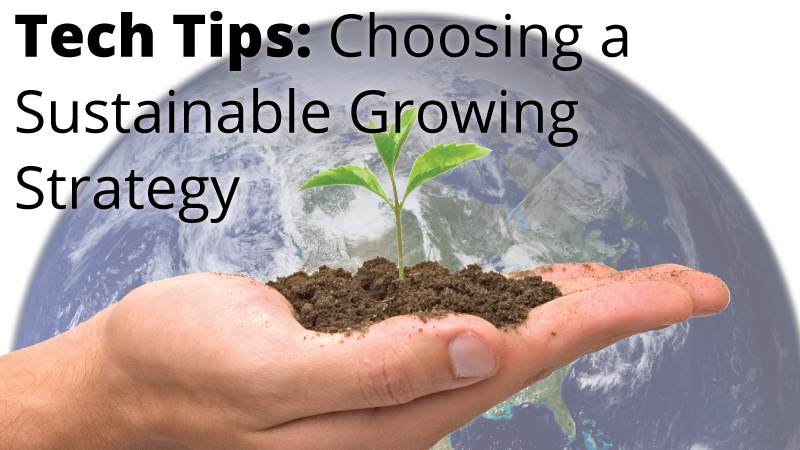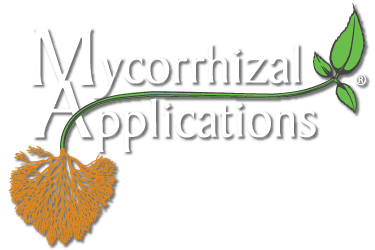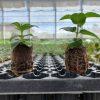I recently watched a political debate for the US Senate. One of the candidates used a phrase that made me think. She said that farmers are a key constituency in the fight to combat climate change. These comments make sense. Farmers have long been given the title of “Stewards of the land”. All of us that are members of the turf and ornamental industry are, in reality, farmers. We should embrace this title, and our stewardship, and take on the battle of running our horticultural businesses in a more sustainable manner.

In this article, we will focus on how the choices you make in developing your production protocol ultimately have an impact on our planet. As is often said, to resolve a problem you have to start at the root of the problem. Well, literally any sustainable growing strategy needs to start below the soil and on the roots of the plants. The symbiotic relationship between plants and mycorrhizae seems like a logical place to start. Mycorrhizae are rhizosphere-based soil fungi that form symbiotic relationships with plants and expand the root absorptive area of the plant up to 50 times. This mutually beneficial relationship starts when the plant root senses the mycorrhizae propagule in the soil or media (typically applied in a horticulture setting via an inoculant product such as MycoApply), and releases a root exudate to activate the mycorrhizae, which in turn attaches to the plant root. Endomycorrhizae actually enter the plant cell, hence “Endo” and Ectomycorrhizae grow in between the plant cells, hence “Ecto”. Once attached, the mycorrhizae then start to develop a mycorrhizal hyphal network in the soil. These hyphae are typically one-tenth the size of a root hair and can extend up to 24 inches (61 cm) beyond where they are attached to the root. Both container-grown and field-grown plants benefit from a mycorrhizal association. This also does not mean a container-grown plant will become more root-bound, however, it means the hyphae will expand throughout the container and capture a greater percentage of the available water and nutrients. Mycorrhizal use, in addition to being good for the planet, saves you money by having less of the nutrient and water you apply drain through the pot and get lost on the ground, thereby also reducing the amount of nitrogen and phosphorus leaching into waterways.
Within the mycorrhizal network of mycelium, nutrient and water absorption occur along the entire length of the hyphae, as opposed to a root and root hair which only absorbs at the tip. With mycorrhizal hyphae, mineral nutrient uptake occurs from both the soluble and insoluble pools in the rhizosphere. Root and root hair uptake only occurs from the soluble nutrient pools. And finally, the rate of uptake is not limited like a root hair, leading to a greater inflow of water and nutrients with mycorrhizal hyphae. Plants form symbiotic relationships with mycorrhizae to develop a more reliable source of nutrients and water; resulting in an increase in plant resilience and ultimately less plant stress.
The transition to mycorrhizal use can be the foundational step as you move towards a sustainable growing strategy. Often I hear growers mention their interest in moving to “softer” growing solutions. These softer solutions are often categorized as Biorational solutions. The term “Biorational” describes a broad range of products that have a reduced environmental impact for the green industries including agriculture, horticulture, forestry, plant health, and others. These products are typically biologically derived or, if synthetic, structurally similar and functionally identical to biologically occurring compounds or materials. Biorational plant products include botanical insecticides, microbial pesticides, plant growth regulators (PGRs), essential oils, minerals, and insect growth regulators. These products give growers the ability to treat pests and maximize plant performance with products that are safer than hard chemistry and have fewer environmental side effects.
Some of the benefits of the use of Biorationals include:
- Many Biorational Products are OMRI Listed and/or OIM
- Consistent with Evolving Consumer Preferences
- Conform to Environmental Stewardship Goals
- Shorter Restricted-Entry Intervals (REI)
- Shorter Preharvest Intervals (PHI)
- Reduced Risk of Phytotoxicity
- Reduced Risk of Pesticide Resistance
- Reduced Health Risks to Plant Professionals
- Key Components of IPM Protocols
- Compatible with Mycorrhizal Inoculant Products i.e., MycoApply
Mycorrhizal relationships give plants the solid foundation they need to be successful in combating stress. In addition to being compatible with biorational plant solution products, they are also compatible with most traditional chemical products. This includes insecticides, miticides, herbicides, nematicides, and most fungicides. There are a few old-school fungicides that should not be applied during the period mycorrhizae develop a symbiosis (connection) with the plant. They can be applied after the symbiosis if it is necessary. For a complete list of fungicide compatibility please go to our website. Mycorrhizal inoculation also works well when growers are transitioning to a sustainable growing strategy or when the plan is to use a combination of traditional and biorational solution products.
As we all know, the key to a better plant is better roots, and decades of worldwide research shows that better roots start with mycorrhizae. Better roots/mycorrhizae allow the plant to better respond to stress. These better roots/mycorrhizae do this by better absorbing more available water and nutrients. Plants grown with less stress have overall better plant health. MycoApply mycorrhizae are not an EPA-registered product. They are considered a soil amendment. Mycorrhizae are not a curative product but can be thought of as a probiotic for plants.
Just like in nature, the MycoApply line of mycorrhizal inoculant products offers multiple species of mycorrhizae. Plants naturally connect with multiple species because each mycorrhizal species provides unique functional benefits. In an effort to maximize benefits and combat stress better, plants naturally want to connect with multiple species of mycorrhizae.
Whenever we hear the story of how a penguin forms a lifelong relationship with their partner we are all emotionally impacted. Mycorrhizae are the same way. Once attached, their survival is aligned with the life of the plant. In that light, mycorrhizae put forth all their efforts to help the plant to survive and thrive. A couple of key points to consider in this light include that mycorrhizae only need to be applied once to a plant. Once established, they are constant companions with the plant throughout its life. Second, the plant controls this relationship. The plant turns the mycorrhizae on and off based on its needs. To maximize the value of mycorrhizae growers should grow drier and leaner. We suggest nitrogen levels below 200 ppm.
Whether your motivation for moving to a more sustainable growing strategy is employee safety, customer requests, a broader vision of your role in combating climate change, or a combination of the above, biorational products can be important tools for you to use in the development of this sustainable growing strategy. Mycorrhizal use is foundational in ensuring the success of this sustainable strategy.
If you have any questions about anything covered in this article or MycoApply Mycorrhizae, please contact your local Mycorrhizal Applications Representative or call 866-476-7800 or email us at inquiries@mycorrhizae.com.
Article by: Blair Busenbark
Mycorrhizal Applications – Sales and Commercial Marketing Manager
November 8, 2022






